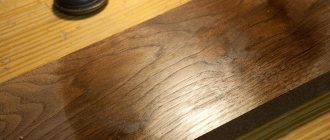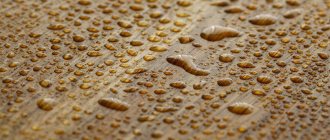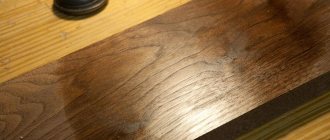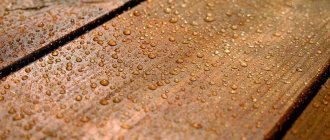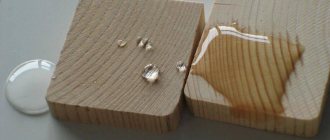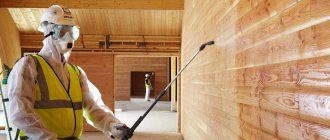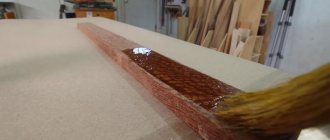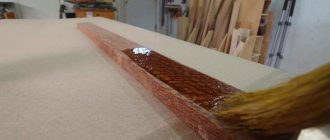Linseed oil and wax for wood treatment is a simple and reliable method that helps ensure wood has a long service life and preserves its properties for a long time. Impregnating wood with linseed oil and wax helps preserve its protective properties. You can prepare a composition for wood processing at home. This is not difficult to do; the materials for manufacturing are also available. On the site you can find a recipe for linseed oil and wood wax. Read the next article on the pages of our magazine.
Positive qualities of wax
Beeswax is a highly viscous substance that has water-repellent properties. It emphasizes the original structure of the wood and provides protection against:
- humidity;
- discrepancies;
- fire;
- fungus and mold.
In addition, wax does not oxidize, so it will remain on the treated surface for a very long time. Thanks to the application of a composition based on this beekeeping product, the wooden surface will remain smooth and shiny for a very long time. Wax also increases the durability of the wood material.
Attention! Antique wooden furniture especially needs waxing.
Wax is an excellent alternative to varnish-based formulations that contain harmful chemicals. Because of them, varnishes have a persistent and characteristic smell, which not everyone likes. These “fragrances” will pollute the air for a long time after the varnish has dried. Using a mixture based on natural beeswax is completely environmentally friendly and safe for people.
If you add coloring elements to the wax-based composition, you can adjust the shade of the wood. In addition, impregnation based on this substance protects wooden products from scratches and even helps remove existing defects on furniture.
Industrial liquid wax
Substances that accelerate the drying process are usually added to industrially produced liquid wax - driers, rosin esters to enhance adhesion, and various others to improve the elasticity and wear resistance of the coating. Therefore, it is sometimes more convenient to use, and the waxing process takes less time. Liquid industrial wax is also tinted. After applying tinted wax, surfaces of different color shades are obtained. From brown and bronze to mahogany and ebony - there is something for every taste. Experienced craftsmen can prepare a coating composition at home that is ideal in consistency on the first try; beginners will have to experiment. Therefore, ready-made industrial molds are more convenient for beginners.
Wax mixtures
Depending on the type of use of wax, there are compositions that are intended to work either inside (furniture treatment) or outside the room.
For interior work
To keep furniture looking like new for a long time, it is coated with wax or wax-based solutions. Colored wax will help change the shade of the furniture, as mentioned above.
Do not forget that high temperatures have a detrimental effect on furniture coated with beeswax impregnation. For example, marks from a regular hot mug will need to be removed by repeated waxing. Therefore, such compositions are not used for furniture located in the kitchen. The same applies to the appearance of scratches - to eliminate them you need to re-wax.
Furniture impregnated with wax is best placed in the bedroom or living room. Wood that has been carefully coated with wax impregnation becomes virtually impervious to external irritants.
Wax compositions for indoor use are designed to cover various wooden surfaces that are not affected by weather factors such as sun or rain. Such compositions are used for the following purposes:
- covering walls, floors and roofs made of wood;
- covering wooden cladding of walls and roof;
- processing of panels, furniture, ceilings.
For interior wax-based work, you can prepare a mixture with rosin. It acts as a crystallizer and creates a durable film on top, but nothing prevents the wood from breathing. The composition is prepared in a water bath in the following sequence of actions:
- Heat the wax to a liquid form.
- Crush the rosin and add to the wax when about half has dissolved.
- After the wax and rosin are completely dissolved, turpentine is added to the composition, and the resulting mass is thoroughly mixed.
Attention! For interior work, it is recommended to use gum turpentine. Its price is a little higher, but it stinks less.
Inexpensive external treatment
Wax-based impregnations intended for use outside the home include oils. These mixtures are used for:
- wooden facades;
- country houses and garden houses;
- gazebos;
- fences;
- other wooden buildings on the street.
Compositions with oil (which will be discussed below) are widely used in cases where wooden surfaces are regularly exposed to external factors. A solution based on beeswax reliably protects wood from humidity, temperature fluctuations, harmful microorganisms and ultraviolet radiation.
These mixtures also contain:
- natural oils;
- substances that guarantee the preservation of wood color and protection from harmful external factors;
- mineral pigments that are light resistant and therefore protect from the sun.
By applying this coating to wood, you can be sure that it will shine and look royal for at least 5 years.
Natural beeswax is quite expensive to use for exterior work, and it is not always necessary. As an alternative, experts recommend using regular paraffin or gasoline for these purposes. You can also use purified acetone. Although its cost is somewhat more expensive, it does not leave a nasty and pungent odor.
It is always worth keeping in mind that both gasoline and acetone are liquids that ignite at the slightest spark .
Therefore, large volumes of mixtures using them must be prepared outdoors. In an enclosed space, a high concentration of vapors can lead to dire consequences.
The main advantages of wax oil for wooden objects
The main advantage of the composition is that it is very easy to apply to a wooden object, which makes it possible to get the job done quickly. This product uses only natural ingredients, so the impregnation is considered safe for health and environmentally friendly.
It is also easy to subsequently repair damaged or replaced areas; the mixture is reapplied to these areas. Caring for the item is easy; dirt is removed from the surface using special means, and then wax and oil are applied again. During the preparation of the composition, various additives are used to give the surface different shades. Using oil wax you can create an antique surface that will highlight any interior style. Wax is used to treat floors, wooden objects or surfaces in a bathhouse; this prevents moisture from penetrating into the material and causing its destruction. Preparing the composition yourself allows you to save money on purchasing various wood impregnations.
Wax mixtures with added oil
Wax impregnation with the addition of oil is extremely effective. These compositions are good for the following:
- the composition with oil saturates the wood as deeply as possible;
- All oil-based mixtures become liquid or turn into a paste when they harden. Therefore, they can always be reapplied without heating;
- the oil makes the wood shine and shine, giving it a chic sheen.
Universal composition
To make wax impregnation using oil, you need to take 2 tablespoons of wax and 5-8 tablespoons of linseed oil. If you take more wax, the product will be thicker; adjust the consistency yourself. The wax should be finely crushed and placed in a water bath, and then add oil when it begins to become liquid. The composition must be stirred constantly until it cools completely.
An ideal option is linseed oil for impregnation. However, there are many options - as your heart desires. Flaxseed oil can be replaced with olive oil and even sunflower oil. What you should not do is add machine oil. After this, it will be almost impossible to remove the pungent odor.
With the addition of propolis
You can also add propolis to oil-based wax impregnation. Take two parts of propolis and one part of wax. To this you need to add 4 parts of linseed oil and place in a water bath. This composition is suitable for hot processing. Shake the mixture thoroughly and rub the wooden product.
Propolis is a completely natural product, the production of which is carried out by bees. Propolis-based mixtures are extremely pure and harmless.
With added lard
If anyone doesn’t know, lard is melted pork fat or lard. The external effect after treatment with a mixture of lard is the same as after propolis. But lard costs much less, so the recipe is budget-friendly.
Accordingly, the technology for preparing and using wax impregnation with the addition of lard is the same as in the case of propolis. Heat 2 parts lard and 1 part wax in 4 parts oil in a water bath. Note that the resulting solution must be applied to a wooden surface 2 times, followed by polishing.
With jojoba oil
This mixture is completely safe not only for processing furniture, but also for children's wooden toys. The composition does not contain harmful elements.
- You need to take 50 grams of beeswax and 150 ml of jojoba oil (you can additionally take extracts and vitamin E). You can use substances in other quantities, but their ratio should always be 1 to 3.
- Grind the wax (for example, on a grater) and melt it in a water bath.
- Add oil.
- To prevent the wax from curdling, it must be constantly stirred until completely cooled.
Scope of application of liquid wax
Depending on the consistency and composition, wax is divided into liquid, solid and water. Each type of wax has its own area of application. Thus, liquid wax is especially convenient when it is necessary to treat a surface with a complex relief shape. For example, furniture richly decorated with carved elements. Hard wax is applied with a piece of soft cloth, and in this case it will not work. Liquid wax is applied with a brush, easily spreads over the surface of any shape, and is used to cover the most complex and delicate decorative elements. It is possible to play with the color saturation depending on how many layers of liquid wax are applied. There are options to make the surface shiny or matte. As a rule, liquid wax for wood contains beeswax and a natural solvent – turpentine.
Wax impregnation technology
- First, preparatory work should be carried out: clean the wooden object from dust and dirt, sometimes grinding work is carried out. If the old surface is covered, the previous treatment is removed.
- Fasteners are checked. Please note that all screws must be immersed in the material by about 3 mm. The caps are sealed with sealant or special putty for wood, the color of which should match the color of the wood. Another option is to perform the treatment using PVA glue with wood sawdust.
- Apply wax to the product with a soft brush. Periodically remove lumps of frozen wax from the brush. To do this, we use a fabric that is free of lint.
- The treated item is left until completely dry, after which it is sanded using a cotton cloth or a special machine.
Attention! The wax coating needs to be renewed about twice a year, while the wood refreshes its appearance.
Waxing of wooden elements
To process a wooden product, you first need to prepare a composition, for this you will need oil, wax, a container for kindling, a brush, a cloth for cleaning the brush, and, if necessary, use various additives to obtain different shades.
First, preparatory actions are carried out, the object is cleaned of dust or dirt, and, if necessary, grinding work is carried out. When the composition is prepared, it is applied to the object with a brush in a thin layer and left to soak thoroughly. In this case, the strokes are done very quickly, without stretching the work so that clear transitions do not form. Periodically remove wax clumps from the brush using a prepared cloth. This way the application will be even. After the wax has been absorbed, sanding is performed using a special machine or a cotton cloth, while the surface of the object remains smooth and shiny.
Waxing
Wax, mastic, oil are traditional materials used by our workshop in the restoration of antique furniture.
During restoration, waxing wood, polishing furniture, impregnating wood with oil, mixtures of wax with turpentine, rosin, and other resins, make it possible to emphasize the beauty, color, and texture of valuable large-porous species of oak, ash, and chestnut. The waxing composition can be purchased ready-made, or you can make it yourself from beeswax, purified turpentine (pinene), and rosin.
Waxing is one of the ways to polish furniture. Its advantages include:
1. Always a quick positive effect.
2. Easy to apply.
3. To apply furniture wax to wood, no special skills are required, as when working with shellac polishes.
What does impregnation for waxing wood consist of?
Impregnation consists of 100g. dry mint leaves, half a liter of vegetable oil, 10g each. - angelica and burdock. All components are mixed together and left for two weeks to saturate, and then applied to the surface with a roller or cotton swab. When the impregnation penetrates into the fibers, the surface can be waxed with a special wax mastic.
In what cases is it necessary to coat wood with stain?
Stain and protective compounds (impregnation) for wood are applied in the same way as if you just wanted to paint it. You should apply the coating to the prepared wood quickly, but in order to get an even coat on smooth wood, you will need to do it very carefully. You must cover each surface continuously, otherwise, if the stain or impregnation on this area dries earlier than on the adjacent one, you will get a noticeable seam in this place.
Apply stain in the direction of the wood grain. Try not to put too much product on the brush and spread out any stray drips before they dry.
Be sure to finish one section before starting the next. At the junctions of two sections, make sure that the applied layers do not overlap. Coating wood with stain is a rather complex technological process. Practice first on an inconspicuous area of wood.
Turpentine, wax, rosin - components of waxing mastic
The basis of any mastic for the restoration of wooden furniture is three components. Solvent, filler, shine former. The main components of mastic for wood furniture are turpentine, wax, and rosin. The amount of turpentine regulates the thickness. The presence of rosin adds shine, shine, and durability.
WAX
is a series of substances that are similar in properties to beeswax. In terms of chemical composition, it is an ester of fatty acids and simple monobasic alcohols.
BEE WAX
the most common, known to everyone. It is obtained from the honeycombs that bees fill with their honey. There are two types: yellow (raw), white (refined). Raw is usually yellow in color, varying in intensity. Has a pleasant honey smell. Purified by melting in water and bleached by the sun or chemicals, it is white in delicate shades. It is often adulterated with stearin, ceresin, lard, etc. The bee product is used for the production of polishes, varnishes, dressings (composition for finishing leather), mastic for rubbing floors, sealing wax, etc.
CARNAUBA WAX
stands out on the surface of the leaves of a special type of palm tree from the tropical regions of America. Especially common in Brazil. There are several varieties. The highest grades are light yellow, almost white, brittle, soluble in ether. Slightly soluble in cold alcohol. It is used for the manufacture of finishing materials, candle production, shoe polishes, and cosmetics.
SHELLAC WAX
obtained by preparing bleached shellac. It is widely used to this day as a by-product in the production of varnishes. It has colors from light yellow to chocolate. It is used for making shoe polishes and gives a good gloss. Neither water nor cold alcohol is its solvent.
JAPANESE WAX
called “wax” conventionally. This is a fat of vegetable origin, extracted from the pulp, seeds, stems, Japanese, Chinese, Korean oilseeds. Dissolves in hot alcohol, ether, gasoline. It is used in the production of finishing materials, care products for furniture, shoes, and cosmetics.
OZOKERITE AND CERESIN
(earth or rock wax) a product of the natural loss of most volatile substances from oil, fossil paraffin, which differs from factory-produced paraffin in its amorphous structure. Ozokerite and ceresin obtained from it by purification have found wide application in the production of polishing mastics for waxing, shoe polishes, and cosmetics. Well-purified ceresin is white or yellow in color.
PARAFFIN
obtained mainly from petroleum. Purified paraffin is white, tasteless, odorless, greasy to the touch. Varieties differ in melting point. For cosmetic purposes, a low-melting one is used (melting point 38-40 degrees), for technical purposes a more refractory one (52-62 degrees). Paraffin is widely used for making candles, in match production, making transparent papers, and for preserving wood, meat, fruits, and vegetables. As an insulating material, finishing.
When restoring polishing, the finished mastic (a mixture with crushed rosin diluted with turpentine) is easily applied to the cleaned wood. Then the restorer, using a brush, brush, or coarse cloth, evenly distributes the finish over the entire area, filling small pores. The result is a cloudy, damp surface. After some time, the solvent evaporates and the surface dries. The wood is ready for polishing. Start rubbing with a hair brush and then with a cloth. Use light sliding movements to wipe flat, carved, turned surfaces. The more thoroughly you polish, the more shiny they will turn out.
Waxing gives a good restoration result if you follow a few simple rules, so to speak, the secrets of the old masters.
1. Before waxing bare wood, be sure to coat it once or twice with a liquid polish solution.
2. If it is necessary to apply more than one layer of mastic, each one must be thoroughly dried at room temperature.
3. Apply in small portions, rubbing well over the entire surface.
4. The final appearance depends more on the thoroughness of polishing than on the thickness of the layer.
The waxed finish is beautiful. She is pleasant to work with. Especially if the mastic is supplemented with all sorts of fragrances in the form of the smell of honey, nuts or some fancy compositions of aromas. The only drawback is its fragility and stickiness. Due to the adhering dust, the exhibit takes on a sloppy appearance. At certain intervals, tables, fronts, chests of drawers and cabinets must be thoroughly cleaned and repolished.
Waxing (waxing, waxing), oil impregnation of furniture, despite its simplicity, is used quite rarely. As a rule, owners of antiques, faced with the difficulties of maintaining the ideal condition of their collectibles, prefer a more expensive but durable shellac finish. It highlights the advantages of walnut, mahogany, and Karelian birch more clearly. Restorers know that mastic is acceptable only on dark, large-porous woods such as oak, chestnut, and sometimes walnut. In addition, it significantly increases the cost of subsequent restorations due to the complexity of removal.
Workshop gallery
Estimated cost of restoration (price as of January 9, 2019)
| Price, rubles | |
| Chair | 5000 — 20000 |
| Armchair | 10000 — 30000 |
| Sofa | 30000 — 60000 |
| Cost, rubles | |
| Table | 10000 — 40000 |
| Buffet | 30000 — 80000 |
| Closet | 30000 — 80000 |
Restoration of paintwork
| Finishing | RUB/sq. meter |
| Waxing | 500 |
| Polishing | 1500 |
| Shellac | 2000 |
| Gilding | 3000 |
| Decoration | RUB/sq. dm |
| Patination | 50 |
| painting | 200 |
| Marquetry | 500 |
| Mosaic | 1000 |
By sending us a completed form with photographs, as well as asking a question, you will receive complete information about the item (what it is, material, age) and the cost of restoration work. Next, the restorer will come to the site, inspect it, and determine the final price of the restoration.
The final price will not change. Departure is free.
Borma Wachs
Borma Wachs is one of the brands of BPSSrl, the oldest Italian manufacturer of oils, waxes and varnishes for wood protection. The company was founded in 1928 and is a model of family business continuity. Products are presented in 50 countries around the world. Official representative in Russia: https://www.borma-wachs.ru/.
Product Features
The manufacturer relied on the use of environmentally friendly components and the selection of recipes to create specialized products. In the company's catalog you will find oils and waxes:
- for furniture, including garden furniture;
- for countertops;
- for any wooden floors;
- for terraces and facades
The range also includes traditional compounds for finishing any wood products exposed to the elements - teak and tung oils.
To give the composition the desired shade, pigment and tinting materials are available. You can choose any color according to the RAL and NCS color models.
Popular formulations from Borma Wachs
| Characteristics | Hardwax Parquet Oil 1030 Quick | SAUNA OIL | teak oil |
| Purpose and properties | Parquet oil with hard wax. Polymerizes quickly. For interior decoration. | Oil for saunas and baths. Prevents darkening and prevents contamination. For interior decoration. | Ready to use for all types of wood. With UV filters. For exterior decoration and garden furniture. |
| Finished coating | Deep matte with a natural effect and 0-5% shine. | Matte, preserving the natural color of the wood. | Transparent or tinted with protection from moisture, light, fungi and insects. |
| Smell during application | Like linseed oil, light. | Without smell. | Characteristic of natural teak oil. |
| Consumption, ml/m² | 80-100 | 60-120 | 80-120 |
| Number of layers when applied | 1-2 | 1-2 | 2-3 |
| Interlayer drying, h | 6-8 | 8-12 | 4-6 |
| Final drying, h | 12-18 | 24-48 | 8 |
| Price | 1562 ₽/l | 1820 ₽/l | 1751 ₽/l |
Check out a short review of parquet oil from Borma Wachs technologist. Some introductory information and a demonstration of the work process and the achieved result.
Conclusion:
Borma products have been represented on the Russian market for more than 20 years. During this time, she gained many adherents. All thanks to the good price-quality ratio, as well as a huge selection of formulations for any occasion. And all this at an average price range.
Treatment of external surfaces
Painting exterior wood surfaces is only required occasionally and rarely. One single layer, renewed every one to two years, will preserve the wood and provide an acceptable appearance. Once a year, lightly strip and wipe off the old varnish and then apply a new coat of paint. External hardwood surfaces will deteriorate slightly faster even if they are treated with teak or Danish oil. Although the wood remains protected, manufacturers usually recommend re-oiling it every year.
- Author: Andrey
Rate this article:
- 5
- 4
- 3
- 2
- 1
(3 votes, average: 3.7 out of 5)
Share with your friends!
Subtleties of using paint on wood
If you are going to mix paints to obtain the desired shade, make sure that all paints have the same base - oil or water. Painted wood requires a protective layer to be applied on top, such as wax or varnish. Paint should be applied along the grain of the wood. Keep the area you are currently working on damp and do not allow it to overlap with areas that are drying. Cover the painted surface with a protective layer. Before doing this, check the manufacturer's specifications to determine the compatibility of finishing materials.
Varnish or stain treatment
Varnish, like stain, must be applied along the grain of the wood, although with this material you should not be too concerned about the accuracy of application. Since most varnishes are completely clear, it is easy to miss untreated areas during application. To ensure overall surface coverage, the work area should be well lit and the treated areas should be inspected regularly. You should move on to the next section after finishing the previous one. Work the brush smoothly to ensure an even layer of varnish.
Wipe off the first coat of varnish, as some types of varnish, especially water-based ones, tend to bleed along the grain of the wood. Wipe the surface with a damp cloth to remove dust and allow the varnish to dry before applying the next coat.
